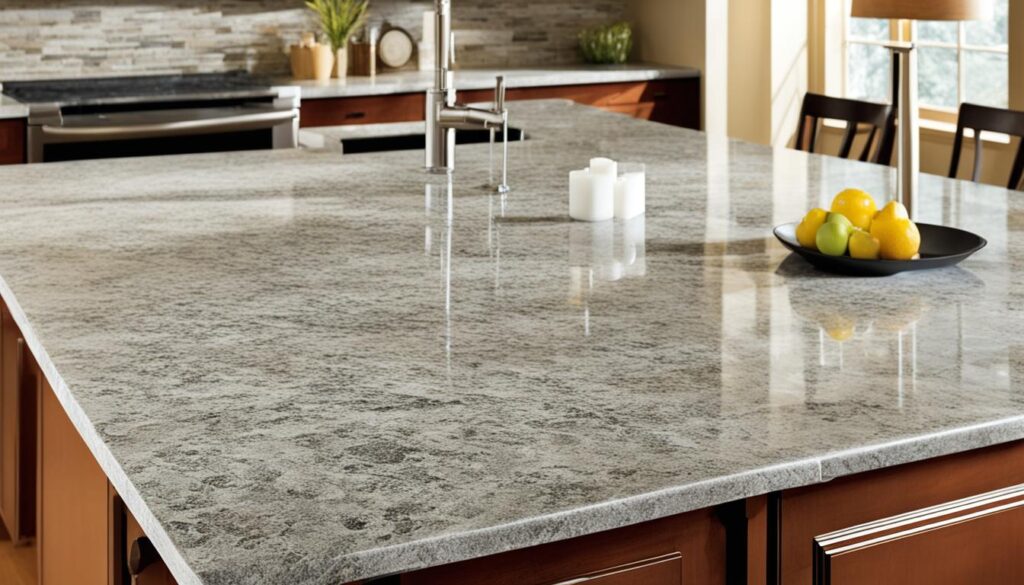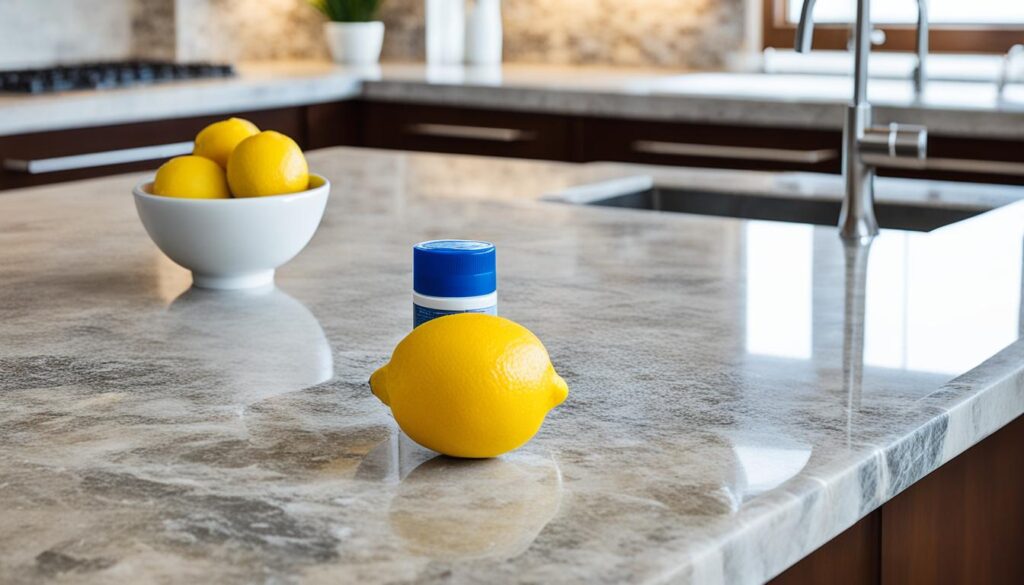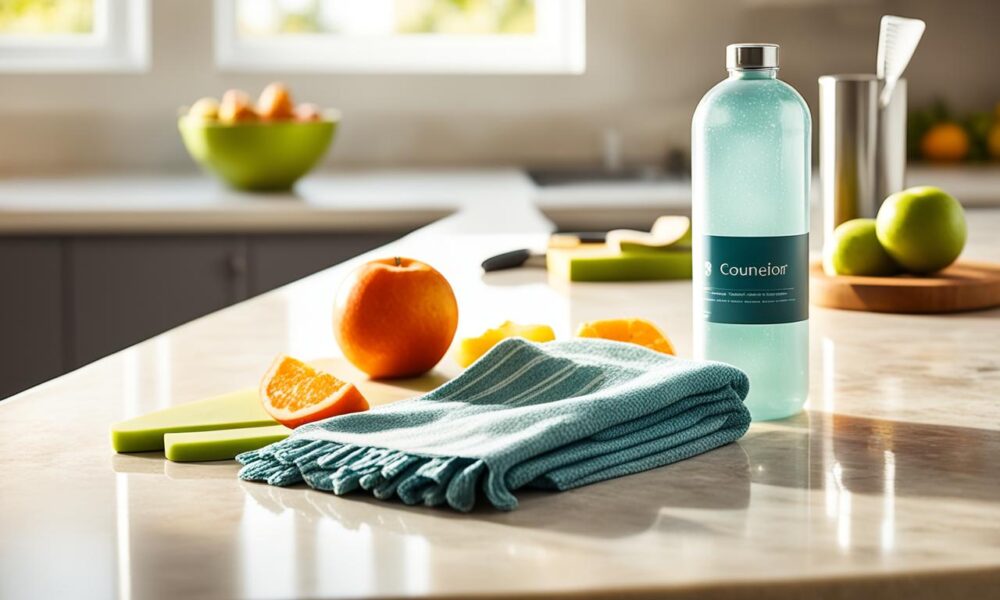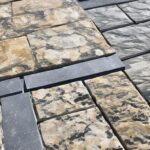Essential Natural Stone Care and Maintenance Tips
Natural stone is a beautiful and durable material that can last a lifetime with proper care and maintenance. Whether you have marble, granite, limestone, travertine, or soapstone surfaces, it’s important to follow these essential tips to keep them looking their best.
Regular cleaning is key when it comes to natural stone care. Use pH-neutral cleaners specifically designed for stone, as acidic or bleach-based cleaners can damage the surface. For deep cleaning, opt for a heavy-duty stone cleaner. When dealing with stains and grout haze, use a stone-specific poultice for effective removal. And don’t forget to seal your natural stone surfaces for maximum stain protection.
Some types of natural stone are more sensitive to acids, so it’s important to be aware and take precautions to avoid etching. If your stone is damaged or worn, it’s best to consult a professional stone restoration company for restoration.
With proper care and maintenance, your natural stone surfaces will continue to provide timeless elegance and charm to your space.
Key Takeaways:
- Clean your natural stone regularly using pH-neutral cleaners designed specifically for stone.
- Avoid using acidic or bleach-based cleaners that can damage the stone.
- Use a heavy-duty stone cleaner for deep cleaning when necessary.
- Remove stains and grout haze with a stone-specific poultice.
- Sealing is strongly recommended for all types of natural stone to provide maximum stain protection.
Achieving beautiful and long-lasting natural stone surfaces is possible with proper care and maintenance. Follow these tips to ensure the longevity of your natural stone and enjoy the timeless beauty it brings to your space.
Routine Care for Natural Stone
Routine care is essential for preserving the beauty of your natural stone surfaces. By following these stone cleaning tips and practicing routine stone care, you can maintain the elegance and longevity of your marble, granite, limestone, travertine, and other natural stone surfaces.
Use Neutral Cleaners
When cleaning your natural stone, it’s important to use pH-neutral cleaners specifically designed for stone. These cleaners should not contain any acid or bleach, as they can damage the stone. Choose cleaners that are gentle yet effective in removing dirt and grime without compromising the integrity of the stone.
Application and Agitation
To clean your natural stone surfaces, apply the pH-neutral cleaner directly onto the stone using a sponge or cloth. Allow the cleaner to sit for the recommended amount of time to loosen and dissolve any built-up dirt. Then, agitate the surface gently with a sponge or soft bristle brush to remove dirt particles effectively. Be cautious when cleaning textured stones, as they may require a different cleaning approach to avoid damaging the unique texture.
Thorough Rinse and Drying
After cleaning, thoroughly rinse the stone surface with clean water to remove any remaining cleaner residue. Use a clean sponge or cloth to wipe away the dirty solution, ensuring a streak-free finish. Finally, buff the stone dry to restore its natural shine and remove any water spots.
Remember that routine care should be an ongoing process to maintain the beauty and longevity of your natural stone surfaces. By following these stone cleaning tips and practicing routine stone care, you can enjoy the timeless elegance that natural stone brings to your space.
| Stone Cleaning Tips | Routine Stone Care |
|---|---|
| Use pH-neutral cleaners | Regularly clean your natural stone surfaces |
| Avoid acidic or bleach-based cleaners | Apply cleaners and agitate gently |
| Choose cleaners designed for stone | Rinse thoroughly and dry the surface |
| Practice ongoing maintenance |
Heavy-Duty Stone Cleaning
When regular cleaning techniques aren’t enough to restore the pristine condition of your natural stone surfaces, it’s time to turn to heavy-duty stone cleaners. These specialized cleaning products are formulated to tackle stubborn dirt, grease, grime, and wax buildup without causing any harm to your valuable stone.
To embark on a deep stone cleaning journey, begin by applying a heavy-duty stone cleaner and degreaser to the affected surface. Allow the solution to penetrate the grime for the recommended duration specified by the manufacturer. This dwell time ensures that the cleaner effectively loosens and breaks down the deep-seated dirt and residues.
Once the cleaning solution has had ample time to work its magic, agitate the surface using a soft sponge or brush. Gently scrubbing the stone will further dislodge any stubborn particles, revealing the true beauty of your natural stone.
Pro Tip: For tough stains or heavily soiled areas, consider using a more abrasive brush to tackle the grime. However, exercise caution and test a small, inconspicuous area beforehand to ensure that the brush does not cause any scratches or damage to the surface.
After thorough agitation, rinse the surface with clean water to remove all traces of the cleaning solution. It is crucial to rinse completely to prevent any residue from affecting the stone’s appearance.
When performing heavy-duty stone cleaning on larger surfaces, it is advisable to change the cleaning solution every 100 square feet. This prevents the reintroduction of dirty water and ensures consistent effectiveness throughout the cleaning process.
Benefits of Heavy-Duty Stone Cleaning
- Effectively removes deep-seated dirt, grease, grime, and wax buildup
- Restores the natural beauty and shine of your stone surfaces
- Preserves the longevity and durability of the stone
- Prepares the surface for more intensive restoration processes, if required
With heavy-duty stone cleaning, you can revitalize your natural stone surfaces and bring back their original luster. This deep cleaning process ensures that your stone remains in impeccable condition, enhancing the overall aesthetic appeal of your space.
Stain Removal Techniques
To effectively remove stains from natural stone surfaces, a stone-specific poultice is the go-to solution. A poultice is a clay cleaning powder designed to absorb stains and grout haze from both polished and unpolished surfaces. Its efficacy varies depending on the nature and age of the stain. Therefore, it’s crucial to select the appropriate type of poultice for the specific stain at hand.
For optimal results, it’s important to act quickly, particularly when dealing with light-colored marble and limestone. Spills should be promptly cleaned up to prevent staining. When using a poultice, if it dulls the natural shine of polished stone, don’t fret. A stone polish can be employed to restore the surface’s luster.
It’s worth noting that different stains may require specific techniques for removal. Below are some common stain types and their corresponding treatment methods:
- Oil-based stains: Apply a poultice made with an absorbent material, such as baking soda or talc, to draw out the oil from the stone.
- Organic stains: Use a mixture of hydrogen peroxide and a few drops of ammonia to lighten the stain before applying the poultice.
- Metallic stains: Treat with a mild acid-based poultice, such as one made from hydrogen peroxide and a few drops of ammonia.
- Biological stains: Combine hydrogen peroxide and a few drops of ammonia before applying the poultice.
- Ink-based stains: Create a poultice with acetone or lacquer thinner to break down and remove the ink.
- Paint-based stains: Gently scrape off as much paint as possible before using an acetone or lacquer thinner poultice.
- Acid-based stains: Due to the sensitivity of natural stones to acids, acidic stains can be challenging to remove. Consult a professional stone restoration expert for guidance in these cases.
“A stone-specific poultice is a versatile and effective method for removing stains from natural stone surfaces.”
Sealing Your Natural Stone
Sealing is an essential step in the care and maintenance of all types of natural stone, such as marble, granite, and limestone. It provides maximum stain protection and helps preserve the beauty of your stone surfaces. Regular sealing should be carried out every couple of years to ensure optimal performance.
When it comes to stone sealers, there are two primary types to choose from: penetrating/impregnating sealers and stone enhancer sealers.
Penetrating/Impregnating Sealers
Penetrating/impregnating sealers are designed to penetrate the pores of the stone, creating a protective barrier. They provide a natural look and are suitable for both interior and exterior use. These sealers do not alter the appearance of the stone, making them ideal for maintaining the original beauty of honed or polished surfaces.
Note: Always follow the manufacturer’s instructions for the duration of the sealer’s protection and proper application.
Stone Enhancer Sealers
Stone enhancer sealers offer an additional benefit by darkening and enhancing the natural color and beauty of the stone. They are particularly effective in showcasing the veining and depth of colors in materials like marble and travertine. These sealers provide both stain protection and an aesthetic enhancement to your stone surfaces.
Note: It is important to test the sealer on a small, inconspicuous area before applying it to the entire surface to ensure compatibility and achieve the desired results.
Benefits of Sealing Your Stone
“Sealing your natural stone not only provides maximum stain protection but also helps prolong the life of the stone and makes it easier to clean and maintain.”
By applying a high-quality sealer to your natural stone surfaces, you create a protective barrier that resists stains from spills, oils, and other contaminants. Sealing helps prevent these substances from penetrating the pores of the stone, making cleanup easier and reducing the risk of permanent staining.
In addition, sealed stone surfaces are less susceptible to damage from etching, as the sealer acts as a barrier against acidic substances that can dull or erode the stone. Regular sealing ensures that your natural stone maintains its original beauty and withstands everyday use.
To enhance the longevity of your natural stone and keep it looking its best, don’t forget to follow proper sealing practices in accordance with the manufacturer’s instructions.
| Types of Stone Sealers | Application | Appearance |
|---|---|---|
| Penetrating/Impregnating Sealers | Interior and exterior | Does not alter natural appearance |
| Stone Enhancer Sealers | Interior | Darkens and enhances natural color |
Acid Sensitivity in Natural Stone
Natural stones, such as marble and limestone, can be sensitive to acids. Even mild acids like lemon juice and vinegar can etch and damage the stone surface. It is crucial to consider acid sensitivity when selecting natural stones for environments where acid exposure is likely.
When exposed to acids, polished finish stones may appear dull and develop etched spots, compromising their beauty. Stones composed of calcium carbonate and those with a high content of calcite are particularly susceptible to acid etching.
To protect your natural stone surfaces from acid damage:
- Avoid using acidic substances, such as citrus juices, vinegar, or harsh cleaning agents, directly on the stone.
- Always wipe up spills promptly to prevent prolonged contact with the stone surface.
- Consider alternative stone options, like granite or slate, which are less prone to acid sensitivity.
- If you need to use acidic products in your kitchen or bathroom, ensure a protective barrier, such as a cutting board or trivet, between the acid and the stone.
By taking these precautions, you can preserve the integrity and beauty of your natural stone surfaces and prolong their lifespan.
| Acid Sensitivity | Stone Options |
|---|---|
| Marble and limestone | Consider alternative options like granite or slate |
| Stones with polished finish | Avoid prolonged contact with acidic substances |
| Calcium carbonate and calcite-based stones | Take extra precautions to prevent acid etching |
Essential Do’s and Don’ts for Natural Stone Care
Proper care and maintenance are crucial for preserving the beauty and longevity of your natural stone surfaces. By following these essential do’s and don’ts, you can ensure that your marble, granite, limestone, travertine, and soapstone surfaces remain stunning for years to come.
Do’s
- Clean your stone regularly with a pH-neutral stone cleaner.
- Seal your stone to provide stain protection.
- Use coasters and trivets to prevent stains and heat damage.
- Dust and sweep natural stone floors regularly.
- Use soft cleaning tools to avoid scratches.
Don’ts
- Don’t use acidic or bleach-based cleaners on your stone.
- Don’t use abrasive cleaners or scouring pads.
- Don’t drag heavy objects across natural stone floors.
- Don’t sit or stand on the edges of stone countertops.
By following these do’s and don’ts, you can maintain the beauty and integrity of your natural stone surfaces. Remember, prevention is key, and regular care will help protect your investment and keep your stone looking its best.

| List of Do’s | List of Don’ts |
|---|---|
| Clean regularly with a pH-neutral stone cleaner. | Don’t use acidic or bleach-based cleaners. |
| Seal your stone for stain protection. | Don’t use abrasive cleaners or scouring pads. |
| Use coasters and trivets to prevent stains and heat damage. | Don’t drag heavy objects across stone floors. |
| Dust and sweep natural stone floors regularly. | Don’t sit or stand on the edges of stone countertops. |
| Use soft cleaning tools to avoid scratches. |
Tips for Stain Identification and Removal
Stains on natural stone surfaces can be a nuisance, but with the right techniques, you can successfully remove them and restore the beauty of your stone. When dealing with stains, it is important to first identify the type of stain you are dealing with. Stains can be categorized as oil-based, organic, metallic, biological, ink-based, paint-based, or acid-based. Here are some tips to help you identify and remove stains effectively:
1. Identify the Stain
Start by observing the stain and its characteristics. Note the location, color, shape, and any surrounding factors that may have contributed to the stain. This information will help you determine the best cleaning method.
2. Choose the Right Cleaning Method
Once you have identified the type of stain, use the appropriate cleaning method. Different stains require different treatments. For example, an oil-based stain may require an oil-stain remover, while a biological stain may need a bleach solution. Refer to the manufacturer’s instructions for recommended household chemicals for each type of stain.
3. Prepare and Apply a Poultice
A poultice is a powerful stain removal technique for natural stone. It is a thick paste-like substance that draws out the stain from the stone. To prepare a poultice, mix the recommended cleaning agent with an absorbent material like baking soda or talcum powder. Apply the poultice to the stained area and cover it with plastic wrap. Allow it to sit for the specified time, usually 24-48 hours, before removing it.
4. Seek Professional Assistance for Difficult Stains
If you are dealing with a stubborn or difficult stain that persists despite your best efforts, it is advisable to seek professional assistance. A stone restoration professional has the expertise and specialized tools to effectively remove even the toughest stains without causing further damage to your natural stone.
By following these stain identification and removal techniques, you can confidently tackle stains on your natural stone surfaces and keep them looking pristine for years to come.
Maintaining the Beauty of Your Natural Stone Countertops
To preserve the beauty of your natural stone countertops, it is essential to follow proper maintenance practices. By implementing the following tips, you can ensure that your stone countertops remain in pristine condition for years to come:
1. Use Coasters and Trivets
To prevent stains and heat damage, always use coasters under glasses and trivets under hot pans on your natural stone countertops. These simple precautions can go a long way in preserving the quality and appearance of your surfaces.
2. Wipe up Spills Immediately
Spills can quickly penetrate the porous surface of your stone countertops, leading to stains. To avoid this, make it a habit to wipe up spills immediately using a soft cloth or paper towel. Prompt action can prevent staining and minimize the need for extensive cleaning.
3. Regular Dust Mopping or Vacuuming
Dust, dirt, and debris can accumulate on your stone countertops over time, causing scratches and dulling the natural beauty of the stone. Prevent this by regularly dust mopping or vacuuming the surface. Use a soft-bristled attachment or a microfiber mop to gently remove dirt and maintain the countertop’s luster.
4. Clean with pH-Neutral Stone Cleaner
When it comes to cleaning your natural stone countertops, opt for a pH-neutral stone cleaner specifically designed for this purpose. Avoid using acidic or abrasive cleaners, as these can damage the stone’s surface. Always follow the manufacturer’s instructions for proper usage and dilution ratios.
5. Reapply Sealer as Recommended
Sealing your stone countertops provides an additional layer of protection against stains and moisture penetration. Reapply the sealer every couple of years or as recommended by the manufacturer. This helps to maintain the stone’s integrity and preserve its beauty for the long term.
6. Address Issues Promptly
If you notice any issues with your natural stone countertops, such as chips, cracks, or etching, address them promptly. Contact a professional stone restoration company to assess and repair the damage. Timely intervention can prevent further deterioration and extend the lifespan of your countertops.
By adhering to these maintenance tips, you can protect the beauty and longevity of your natural stone countertops. Incorporate these practices into your regular cleaning routine to ensure that your countertops remain a stunning focal point in your space.

| Tip | Description |
|---|---|
| Use Coasters and Trivets | Prevents stains and heat damage |
| Wipe up Spills Immediately | Prevents staining |
| Regular Dust Mopping or Vacuuming | Removes dirt and debris |
| Clean with pH-Neutral Stone Cleaner | Avoids damage from acidic or abrasive cleaners |
| Reapply Sealer as Recommended | Provides additional stain protection |
| Address Issues Promptly | Prevents further damage and deterioration |
Conclusion
Proper care and maintenance are crucial for preserving the beauty and longevity of your natural stone surfaces. By following these essential tips for stone maintenance, you can ensure that your marble, granite, limestone, travertine, and soapstone surfaces remain stunning for years to come.
Regular cleaning is key to keeping your natural stone looking its best. Use pH-neutral cleaners specifically designed for stone and avoid acidic or bleach-based cleaners that can damage the stone. Additionally, consider deep cleaning using a heavy-duty stone cleaner when necessary to remove dirt, grime, and waxes without harming the surface.
Stain removal techniques are vital for maintaining the appearance of your natural stone. Utilize stone-specific poultices to remove stubborn stains and grout haze, taking into account the nature and age of the stain. Remember to address spills immediately to prevent staining, particularly on lighter-colored marble and limestone surfaces. In case the poultice dulls the shine of the polished stone, you can restore the natural shine with a stone polish.
Sealing your natural stone is strongly recommended to provide maximum stain protection. There are two types of stone sealers to choose from: penetrating/impregnating sealers and stone enhancer sealers. Always follow the manufacturer’s instructions for the duration of the sealer’s protection and proper application to ensure long-lasting results.
By adhering to the do’s and don’ts of natural stone care, you can prevent damage and prolong the life of your surfaces. Remember to clean regularly, seal your stone, use coasters and trivets, and avoid using abrasive cleaners or dragging heavy objects across your natural stone floors. Taking these precautions will ensure your natural stone surfaces continue to exude timeless elegance and charm in your space.



